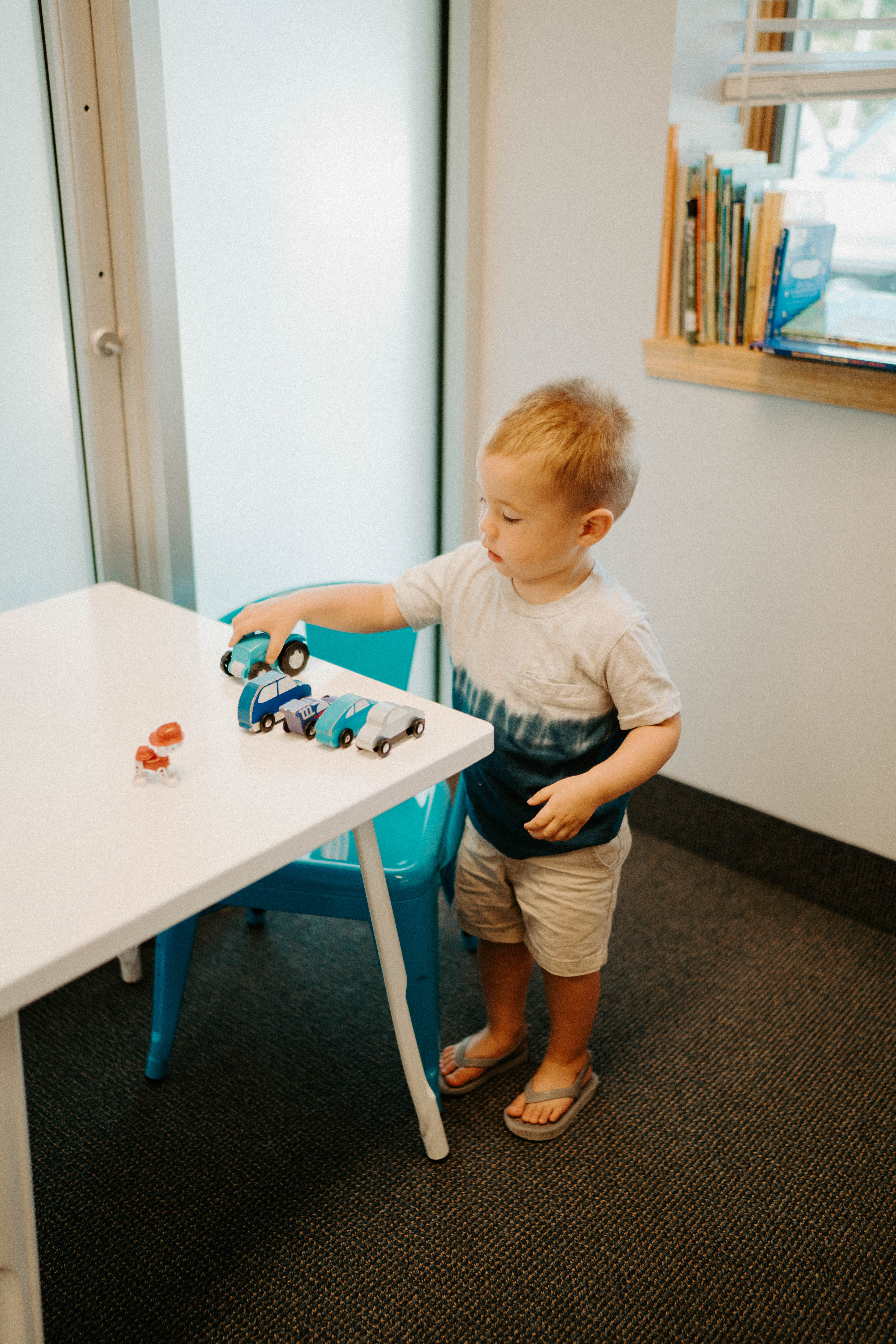WElcome TO
Explore our blog that focuses on holistic care for any and all ages - pediatric well-being, pre/post-natal health, and adult vitality.
THE BLOG

Neurological healing is no easy task. Nor is it normally a linear, straightforward path. In fact, it’s most commonly quite the opposite, going through multiple stages and phases on its way to optimal healing and outcomes.
The first challenge parents and patients face when trying to determine whether or not things are moving in the right direction with neurological healing is that the process is the stark contrast opposite of traditional medical treatment. Every single component of the medical system is designed not with healing in mind, but with suppressing, stopping, and shutting things down as the ultimate goal.
Have an infection? Kill it off with an antibiotic (which literally means anti-life).
Have a fever? Shut it off with a fever suppressor.
Have inflammation? Shut it down with steroid-based medications.
Have hyperactivity and impulsivity? Suppress it with stimulant medications.
Have anxiety? Cover it up and suppress it with drugs.
The medical way is one that is supposed to “work” fast and, therefore, be readily apparent. Unfortunately, parents today especially know that what we discussed is very true – the vast majority of the time, drugs and medications are doing nothing to address the actual root cause, create any actual healing, and they also come with a whole host of unwanted side effects.
So, what other options do we have? Well, if you’re reading this, then it’s likely that you’ve already begun to take the root cause of yours or your child’s challenges head on with neurologically-focused chiropractic care, or you’re strongly considering it and wondering exactly how that process works.
To make this super simple to understand, we’ll be breaking things down into three parts. First, the healing phases we’ll discuss are:
- Release Phase
- Rebuild + Reorganize Phase
- Restoration Phase

Phase 1 – Release
The first phase of neurological healing + restoration is often the bumpiest. The longer you have been subluxated and stuck in sympathetic dominance (dysautonomia), the deeper those stress patterns and dysfunctions set in. The body is doing all it can to adapt, but in the toughest of cases (Perfect Storm + Neuro Intensive ones especially), we generally find that the nervous system is just flat out worn out and exhausted.
Therefore, when you release those deep subluxation patterns in the first two (2) weeks to two (2) months of care, oftentimes, patients will experience some form of “neuro detox” where certain signs and symptoms may get a bit worse.
This is really no different than what happens when you get a fever, diarrhea, or traditional immune response – the body is actually getting “sick” to get well again.
So, in the vast majority of these neurological detoxes that occur way early in care, it’s actually a “good” sign that healing is happening. We’re getting the nervous system unstuck from the long-standing stuck, stressed, and exhausted subluxation patterns it’s been in.
Phase 2 – Rebuild + Reorganize
This is an exciting phase of care, and it’s really rooted in the science of something called neuroplasticity. Which honestly is what all of neurologically-focused chiropractic care is based upon.
Neuroplasticity, also known as neural plasticity or brain plasticity, is the ability of neural networks in the brain to change through growth and reorganization. It is when the brain is rewired to function in some way that differs from how it previously functioned.
Subluxation, dysautonomia, and the “Perfect Storm” are all what stop neuroplasticity, growth, and optimal development dead in its tracks and throw things off course. Therefore, when we hit this stage of care, and we start to see growth and reorganization happening again and a child getting back on track with their milestones and development – oh man, is it exciting!
What does rebuilding + reorganization look like practically? Check out the following list to spot the signs of this stage in progress:
- INSiGHT Scans shifting, changing, calming, clearing, and reorganizing
- Oftentimes this can be tracked with our “neurometrics” and scores
- Improved Neuro-Postural Patterns
- No more head tilt + rotation, shoulders relaxed and level, etc.
- Improved Neuromuscular Tone + Coordination
- Observed through movement, gait analysis, etc.
- Improved Neurological “Soft Signs”
- Sleeping better, eating better, improved digestion, better immune health, improvements in posture and coordination, etc.
- Improved Focus + Endurance in School, Therapy, etc.
- Being able to do more during therapy appointments and school
- Less Severe Subluxation Patterns and Adjusting Restrictions
- When things shift, move, and get easier to adjust
By no means does a child or patient need to experience everything on that list to be in this phase of neurological healing, as healing is unique to each individual. However, even observing and having just a couple of them means things are progressing and on the right track to optimal healing and neurological restoration!
Phase 3 – Restoration
This phase of care is the ultimate goal of our initial care plans, but honestly, it’s just the beginning of the best part – the child or patient is now experiencing a high quality of LIFE once again!
We feel strongly that we are designed to be strong, healthy, resilient, and happy, and therefore live a high quality of life as a result! This stage of care is when kids and patients really have had transformative changes with their health and day-to-day experience a quality of life far greater than what they had prior to starting chiropractic care.
This stage then sets the stage for wellness, but the work is not all the way done. In this stage, we want to stay on the job of neurological healing and continue to deploy neuroplastic healing principles in order to put “slack” and “stability” in the system.
This third state of neurological healing is essential for one reason – life goes on. Meaning kids are still going to have growth spurts, falls and injuries, colds and sickness to get through, social and emotional challenges, school, sports, seasonal changes, and so much more they still need to stay ahead of and adapt to. Adults are right there with them with work stressors, seasonal allergies, social engagements, and other physical stressors.
By completing this final stage of the neurological restoration care plan, we can then transition into lifetime wellness care with a strong, resilient, and more stable nervous system. A more stable nervous system can better withstand various regular life stressors and stay healthy and strong through them!
That is the ultimate goal we have for our patients – to not just get healthy for a season, but stay there for good! To do that, this third phase and achieving restoration is essential.
Diving Deeper into Neurological “Soft Signs” of Healing
While every single one of us, from the parent team to the provider team, wants to see massive changes and achievement of the big goals happen right away… science and clinical experience let us know that, typically, that is not the case.
So often, and so rightfully so, some of the most common examples parents have for BIG goals for their children’s care include things like starting to walk or talk, eliminating seizures or autism spectrum related challenges, improving focus and behavior, lessening anxiety and depression, and so forth. For the purpose of this article, we’ll refer to these functions as “brain-based” or “higher level” functions.
In contrast, more primary and basic neurophysiological functions that are essential to health are things like eating, sleeping, digestion (pooping), motor planning, respiratory + immune health, and so forth. These core health functions could also be called more primal or foundational components of health, and what many parents and providers don’t know is it’s these things that get offline and off track first, which then leads to the bigger “brain based” problems down the road as neurological function and development is compromised.
Therefore, on the road to optimal neurological healing, we often need to see changes with these “soft signs” (and scans), and the more basic physiological functions first.
- When a teen intensive patient struggling with anxiety, epilepsy, and exhaustion starts to finally fall asleep easier and stay asleep longer, we know we’re on the right track!
- When a three (3) year old patient recently diagnosed with autism and apraxia (nonverbal) begins experiencing better digestion, immune health, and gross motor planning, we know we’re on the road to recovery + restoration!
- When a grade schooler struggling with ADHD and behavioral regulation challenges has more relaxed shoulders, less tension, and gets adjusted easier, we know we’re making the right changes happen to their nervous system!
So often for parents, not seeing the big changes happen instantly with chiropractic care can be frustrating and, if we’re being honest, even disheartening. But when we can point out these incredibly important changes on their INSiGHT Scans and with their neurological “soft signs,” we can rebuild that hope and let you know we’re heading in the right direction!
If you have any questions at all about what phase of care your child is in (or yourself), do not hesitate to ask and really dig in with your doctor at the next visit. We love talking through this stuff with our patients, and always do our best to stay ahead of it, making sure you know what to look for and what to track as care progresses through each and every phase of care!

Are you exhausted from the daily mealtime battles with your picky eater? If you’ve tried hiding vegetables in smoothies, created elaborate reward charts, or found yourself negotiating “just one more bite” at every meal, you’re not alone. As a parent, these struggles can leave you feeling frustrated, worried, and sometimes even like you’re failing.
But what if we told you that your child’s picky eating likely isn’t really about the food at all?
Beyond Behavior: Understanding What’s Really Happening
Studies show that up to 22% of children are classified as picky eaters, with 40% remaining picky for two years or longer. While most healthcare providers suggest waiting it out or trying various behavioral approaches, they’re often missing a crucial piece of the puzzle: the nervous system connection.
The truth is, picky eating frequently has less to do with stubbornness or behavior and more to do with an overwhelmed nervous system.
Let us share a story that might sound familiar. Leo’s family faced significant challenges with his eating habits — there were many days when he wouldn’t eat at all. His mom felt completely helpless, especially when their pediatrician kept saying he would “grow out of it.” They tried speech and eating therapy but saw little progress.
Everything changed when they discovered that Leo’s nervous system was overwhelmed. Once they addressed this root cause, Leo’s sensory skills improved dramatically, his meltdowns decreased, and he began eating regularly. He transformed from a struggling picky eater to a thriving, happy toddler.
The Nervous System Connection
To understand what leads to picky eating, we need to look deeper at what’s happening neurologically:
Sympathetic Dominance: When Your Child’s Body is in “Fight or Flight”
Your child’s picky eating likely stems from a neurological state called “sympathetic dominance” — where their nervous system is stuck in a constant “fight or flight” mode. This creates several challenges:
- Sensory overload makes normal food textures, smells, and tastes feel overwhelming or even threatening
- A stressed nervous system actually programs the brain to crave simple carbs and sugars that can be quickly converted to energy
- What seems like a normal mealtime to you feels like a battlefield to your child’s body and brain
The Three Root Causes of Picky Eating
1. Sensory Processing Challenges
When there’s stress or subluxation in the upper neck and brainstem regions, it creates nervous system imbalance. This leads to heightened sensitivity to food textures, temperatures, and tastes.
What might seem like a normal food texture to you can feel extremely uncomfortable or even painful to your child. That soggy cereal or slightly lumpy yogurt isn’t just unappealing — it might trigger a genuine sensory aversion.
2. Vagus Nerve Dysfunction
The vagus nerve is crucial as it controls digestion, appetite regulation, and the gut-brain connection. When this nerve isn’t functioning optimally, it disrupts natural eating patterns.
This can cause digestive discomfort, making children associate eating with unpleasant experiences. No wonder they become hesitant at mealtimes!
3. Oral-Motor Coordination Issues
Proper neural connections affecting the cranial and cervical areas impact chewing and swallowing abilities. When these aren’t working efficiently, children often prefer soft, simple-to-eat foods.
The struggle with certain textures isn’t stubbornness — it’s a physical challenge requiring proper neurological support. When your child says they “can’t” eat something, they might be telling the literal truth.
Why Traditional Approaches Often Fall Short
Now it becomes clear why hiding vegetables, using reward charts, or creating mealtime rules often don’t create lasting change. These approaches focus on behavior modification without addressing the underlying neurological causes.
It’s like trying to teach someone to swim while they’re actively drowning — they can’t learn new skills until they feel safe.
A Different Approach: Supporting Your Child’s Nervous System
Understanding these neurological connections is the first step toward real, lasting change!
Remember Leo’s story? His transformation didn’t happen overnight, but addressing the root cause — nervous system dysfunction — made all the difference. His mom went from feeling helpless to empowered, and mealtimes transformed from battlegrounds to bonding time.
At Rochester Chiropractic and Wellness we use advanced INSiGHT scanning technology to identify specific areas of nervous system subluxation that might be contributing to your child’s picky eating. Our gentle precise adjustments help restore nervous system function, allowing your child’s natural eating instincts to emerge.
Don’t let another meal end in tears and frustration. With the right support and understanding, your child can develop a healthier relationship with food, and your family can enjoy peaceful mealtimes together.

As a parent, watching your child struggle with chronic health issues can feel like being trapped in an endless maze. You’ve tried everything – special diets, medications, supplements, various therapies – yet the breakthrough you’re desperately seeking remains elusive. If this resonates with you, you’re not alone, and more importantly, there’s hope.
When “Trying Everything” Still Isn’t Enough
Let me share a story that might sound familiar. Hannah was just 11 years old when her family found themselves at their wit’s end. Diagnosed with psoriatic arthritis, she battled daily with nausea, headaches, digestive issues, chronic fatigue, anxiety, and depression. Her family had explored countless options: special diets, supplements, medications – even chemotherapy. Nothing provided lasting relief, and Hannah had reached such a low point that she felt empty and didn’t want to live anymore.
This scenario plays out all too often for families dealing with various conditions, from Autism and ADHD to Epilepsy, PANS/PANDAS, allergies, and asthma. Parents exhaust both traditional medical routes and alternative therapies, yet their children continue to struggle.
The Missing Piece of the Puzzle
There’s a crucial piece of the healing puzzle that most healthcare practitioners – both traditional and alternative – often overlook entirely.
It’s not about finding the next treatment or therapy; it’s about understanding the proper sequence of healing.
The Foundation: Your Child’s Nervous System
Think of your child’s body like a house. The nervous system is the foundation, developed first in the womb and controlling every other bodily function:
- Gut health and immune function
- Sensory processing and speech
- Motor development
- Emotional and behavioral regulation
- Focus and cognition
When this foundation is compromised, it’s like building a beautiful house on unstable ground. You can invest in the finest furniture, most advanced security systems, and gorgeous decorations, but if the foundation is cracked, nothing will function as intended.
Understanding the “Perfect Storm”
Three key factors often contribute to nervous system dysfunction:
- Pregnancy Stress Impact: High levels of stress during pregnancy can affect the developing nervous system
- Birth Interventions: C-sections, forceps, vacuum extraction, and other interventions can create physical trauma to the brainstem and vagus nerve
- Early Environmental Factors: Early exposure to antibiotics and environmental toxins can trigger inflammation and compromise the system further
Why Traditional Approaches May Fall Short
When we try to address “brain-based” issues without first stabilizing the nervous system, it’s like trying to repair a roof while the foundation is still shifting. This explains why many children show minimal improvement despite trying numerous interventions – we’re working in the wrong order.
The body follows a specific developmental sequence:
- Nervous system
- Motor system
- Gut and immune health
- Brain function
A New Path Forward: Neurologically-Focused Care
This is where neurologically-focused chiropractic care comes in. Unlike traditional medical treatments that might only address symptoms, this approach:
- Identifies and addresses subluxation, or nervous system dysfunction, that standard medical tests might miss
- Uses specialized neurological scans to pinpoint areas of concern
- Provides gentle adjustments to help restore proper nervous system function
- Creates an environment where other therapies can work more effectively
Hannah’s Breakthrough
Remember Hannah? Everything changed when she discovered neurologically-focused chiropractic care. After her very first adjustment, she experienced immediate relief – sleeping through the night, feeling less nauseous, and regaining her appetite. Today, she’s not just surviving; she’s thriving.
Taking the First Step
If you’re feeling exhausted from trying everything without success, have faith that this might just be the missing foundational piece in your child’s healing journey.
At RCW, the journey starts with understanding your child’s unique needs through specialized neurological assessments. These INSiGHT Scans can reveal if nervous system dysregulation might be holding your child back from complete healing, and if so, we can create a personalized path forward.
Your Next Steps
- Get Assessed: Schedule a consultation and INSiGHT Scans to identify areas of subluxation and understand your child’s specific needs
- Start with the Foundation: Address any nervous system dysfunction with gentle adjustments before adding other interventions
- Build Systematically: Work with your healthcare provider to develop a sequential healing plan
- Stay Hopeful: Remember that healing is possible when we address the root cause
So often, the breakthrough you’re looking for starts with going back to the foundation and building from there. Your child’s healing journey might not be a straight line, but with the right approach and proper sequence, lasting improvement is absolutely possible.







